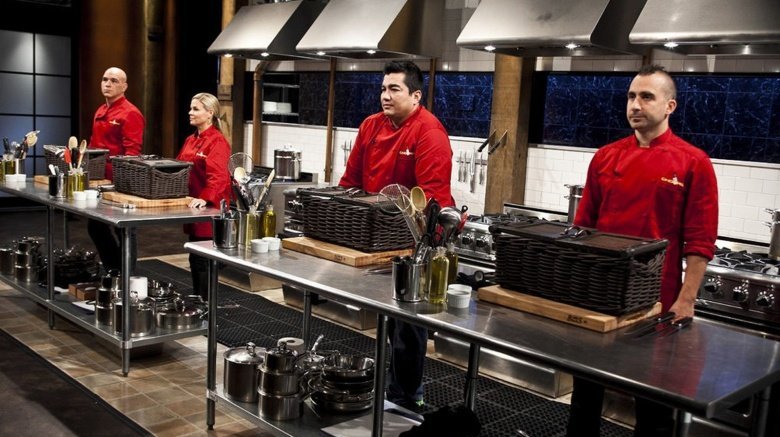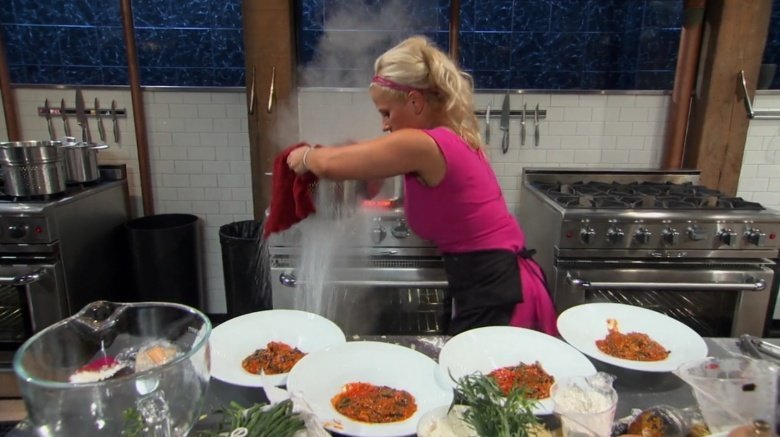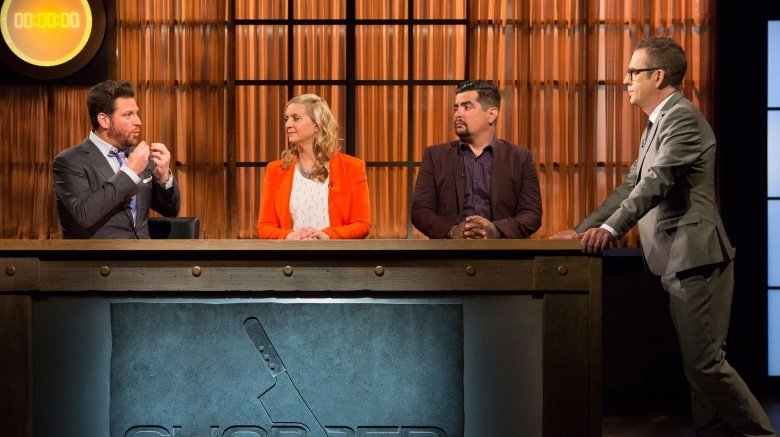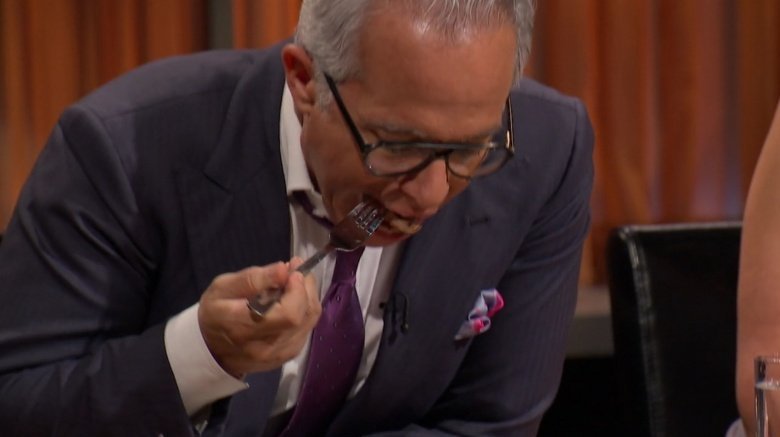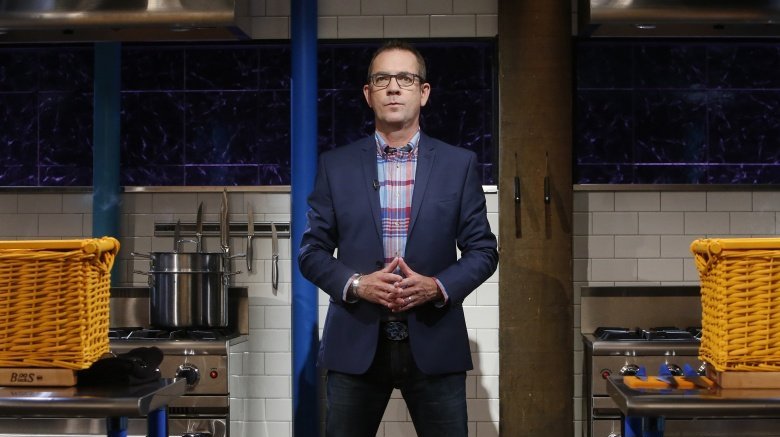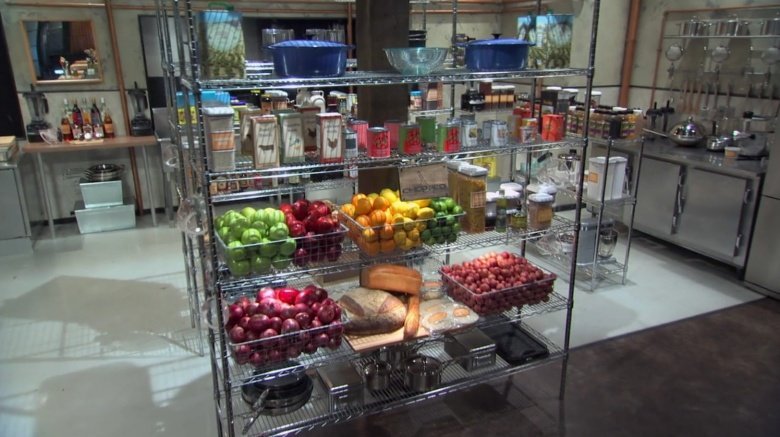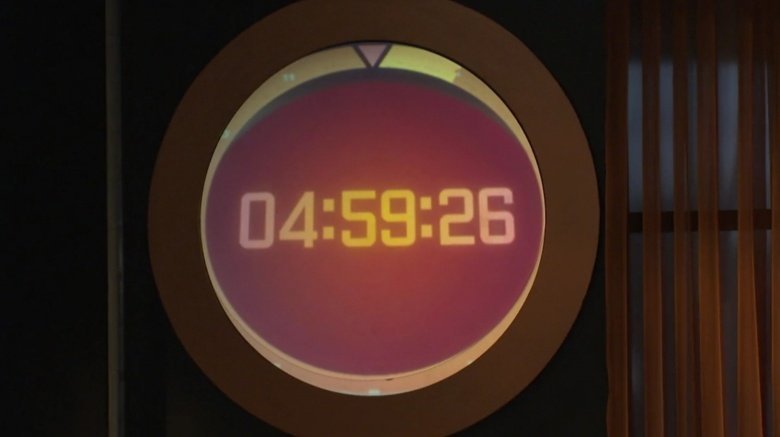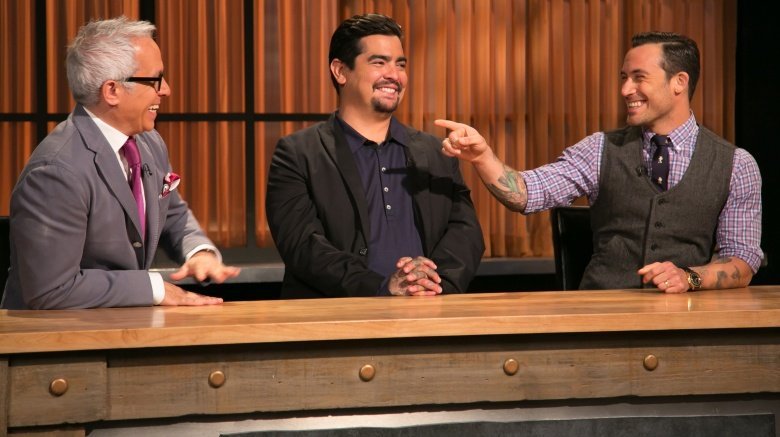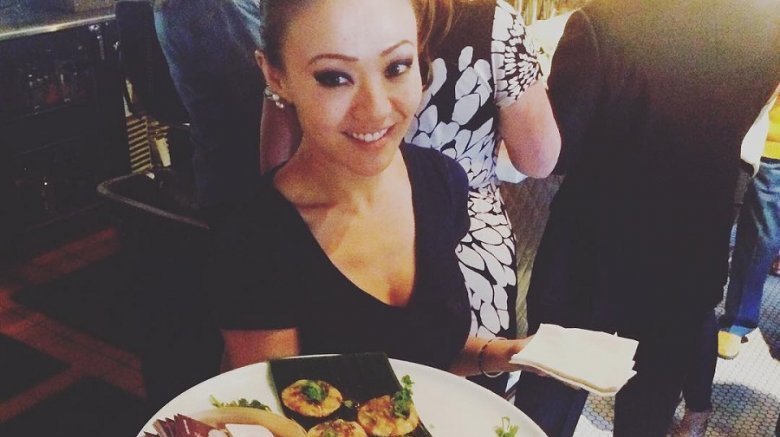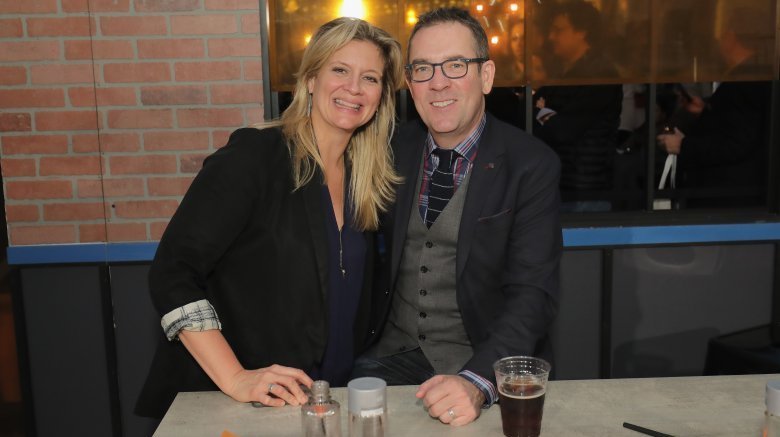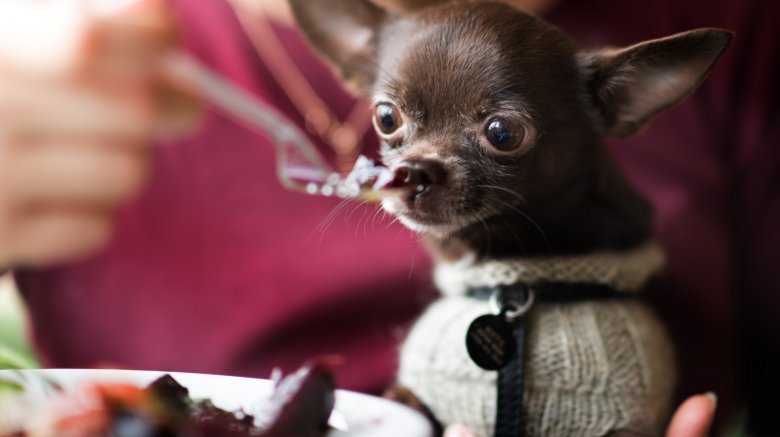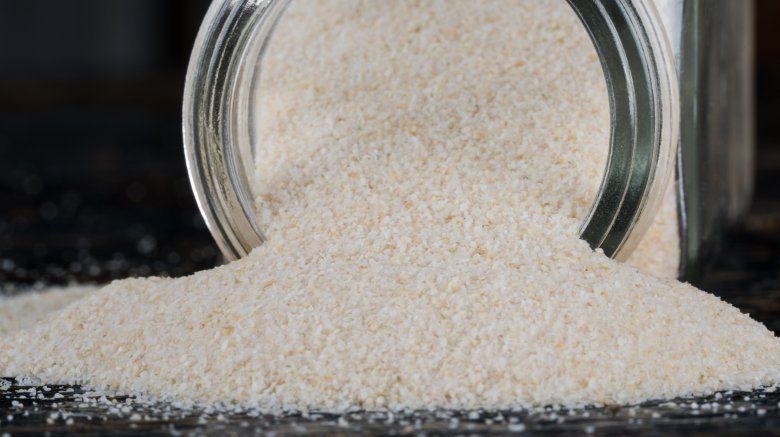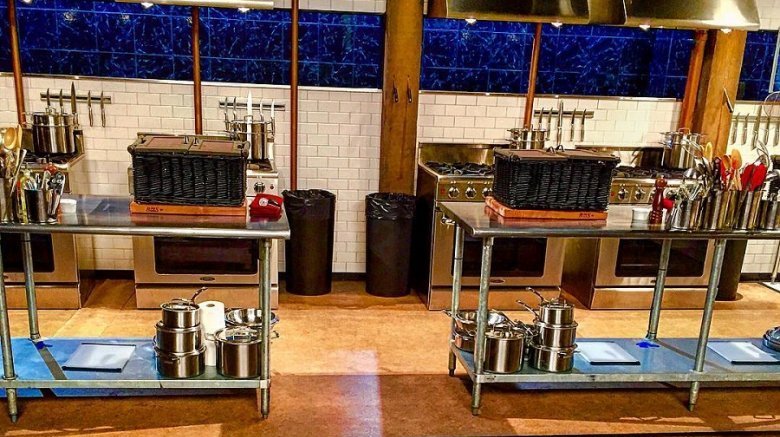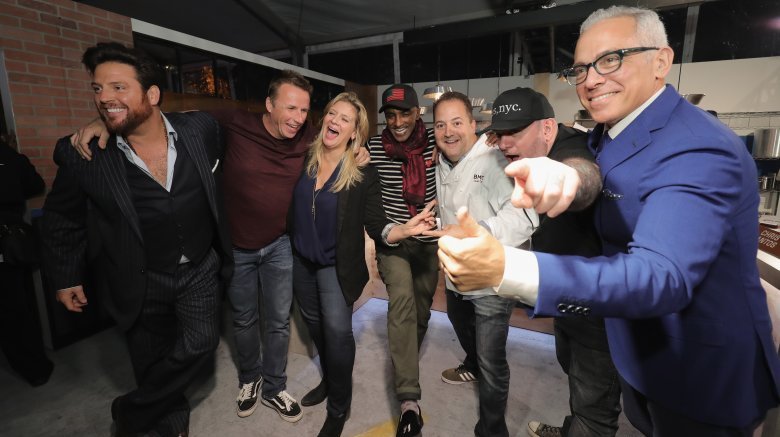What Chopped Will Never Tell You On Air
With 40 seasons under it's belt, it's no wonder that Chopped is one of the most popular shows on Food Network. It's a fast-paced cooking show, with a ton of drama, lots of interesting characters, and a bunch of octopuses, all rolled into a neat, one-hour package. But, nothing is quite what it seems on the surface, especially when we're talking about a TV show. As you probably guessed, Chopped isn't as free-flowing as it seems — and a lot of the things that seem to make it extra challenging, don't happen that way at all. Let's take a deep look at how Chopped, and what it's really like, both for the judges and the hopeful contestants.
They want chefs with a story
Chopped is a TV show first and foremost. The producers are looking for an angle that will play on TV. When the contestants go into details about their lives, their stories are usually fairly compelling. That's not by accident. The process of getting on the show includes filling out an application and sending in some photos of yourself because the right look matters on a TV show.
If you make it to the next round, you get a video interview with the producers asking personal questions. Do you get nervous when someone you just met bombards you with personal questions? Great! You have anxiety, and your angle is you're going on the show to overcome it.
When they do find that good backstory, sometimes they play up part of it to tug on the sympathy heartstrings a bit more, even if it's not exactly the case. For example, on a Chopped Junior episode, producers played up Sequoia Pranger's divorced parents despite the fact that it happened when she was a toddler and she and her mother said it had no ill effects on her life.
Some stuff is manipulated for TV purposes
If the show was completely real as you see it, you'd have the reveal, the shocked look of chefs trying to figure out how sweetbreads and Kit Kats go with gnocchi and Mountain Dew, and then a whole lot of nothing.
If you have 30 minutes to cook, and you're baking and boiling, you're not going to stand around watching and waiting. To facilitate that, the ovens are set to 350 degrees and the water is boiling before the baskets are even opened. And those reaction shots — the stunned looks on chefs' faces — are semi-staged. Yes, the looks are real, but they may do several takes to get the right angle. Contestants might re-open the baskets a few times (with a cloth covering the ingredients) before getting to actually open the baskets and start.
Questionable chops
Part of the "plays good on TV" aspect has led to some questions about whether people were kept more on personality rather than cooking skill. So is it a cooking competition or a semi-scripted show?
There's no doubt that a gregarious personality helps, but is that enough to get a contestant through? Let's delve deeply into a specific example. On one side, we have John Sierp, a loud New Yorker with Food Network TV experience. On the other, Linda Laestadius, a mousy Swede. They competed in the appetizer round with chicken wings in the basket. Sierp had a bit of a disaster; his oil wasn't hot enough to deep fry the wings, so in a fit of panic he boiled the wings. Anyone for rubbery, airport bar chicken wings? Laestadius did have a tiny bit of pink in the middle of one wing — which is perfectly fine if the internal temperature hits 165 degrees, although she didn't measure, so we don't know for sure. More importantly, she used all the ingredients, while Sierp left one out. That's a major no-no to fans, but Sierp made it through; Laestadius got chopped.
That raises eyebrows. How can a guy who left out a basket ingredient make it through? Sure, it happens occasionally, but not when the dish was rubbery chicken. Is it truculence over taste? Sierp thinks it's more about who makes for better TV.
Some tasting is done early
If you ever wondered how stuff can stay warm by the time it gets to the judges, wonder no more. Judges can get a sample early. It's only logical because if you're making something crispy or a sauce that can congeal and it sits around too long it won't be good eats. The contestants are informed that nothing special needs to be done to assure the food makes it to the judges at the right temperature.
And even though making ice cream on Chopped seems like the culinary equivalent of Michael Corleone kissing you on New Year's Eve, it's not because it's all melty-melty by the time it reaches the judges. It's because the contestant made a bad ice cream.
The nondisclosure agreement is steep
The key to a successful television show, regardless of reality or scripted version, is the element of surprise. There is legal precedent for contestants who break nondisclosure agreements to wind up on the wrong side of a lawsuit. Survivor had an infamous leak incident that raised the stakes for every show to tighten the reigns.
The Chopped Junior nondisclosure agreement is available online. Unless your hobby is reading over-broad legal writing, here's the quick version: blab and it's $750,000. And that's why finding results pre-airing of Chopped is as rare as ordering up dodo cacciatore at Pizza Hut.
The pantry isn't a surprise
Let's paint the scene: there you are, TV lights beating down on your already sweaty forehead. A basket, three judges, and a plethora of crew staring at you. You fling open the basket and find the ingredients. You formulate your culinary dance, and then run over to the pantry and spend five minutes looking for the Hungarian paprika. Where is it?!
Relax. Prior to each round, contestants have an opportunity to walk around the pantry for a few minutes to familiarize themselves. And they do it prior to every round because, as you likely guessed, the pantry contents change depending on the basket ingredients and the round. That goes for the refrigerator as well. It's possible for a contestant to put two and two together to get an idea of what might be coming; you can only use apple pie spice in so many dishes, after all.
You always know the time
The panicked rushing around is real. The having-no-idea-how-much-time-you-have-left isn't. That's just for the viewer to feel at home. Yes, it's a mad scramble to make your way around the television kitchen, but they don't want it to be down right silly. The chefs are given numerous time updates. For those untrusting souls, there is a clock available to glance at but really the fear of running out of time because you didn't know how much remained just does not happen.
And yes, to your next question: the time limits are real. You get exactly 20 minutes for the first round and 30 each for the next two.
The judging takes about forever minutes
Remember John Sierp? Of rubbery, boiled chicken fame? What appeared on TV sure made it seem like he slipped each judge a fiver and asked 'em to keep it clean. But what actually happens is great detail from each judge. The judging round takes approximately 90 minutes. Each judge will go over every single morsel on the plate. And since they pre-judged specific items, they'll come back and address those for the camera.
So what really happened when John Sierp served up a warm plate of disgusting? He says the judges loved his appetizer. The others were not as good as his to the point where he wasn't even second to last, in his opinion. They just creatively edited the comments to look like he had to sweat it out. That's the power of television; 20 minutes of "I love this" narrowed down to the solitary, 30-second negative comment to build up the tension.
It takes 14 hours or more to film an episode
Just watching Chopped can be a bit exhausting, especially when you start sympathizing with the chefs on screen. But it's even more intense than you think, and according to former contestant Kathy Fang (via Delish), chefs are in for a non-stop, 14-hour day that starts when they get to the set at 5:45 am. They've already been up and at 'em for a while, too, as they have to be ready to go on camera — there are no stylists waiting for them.
Of course, how long the day is depends on how far you make it. If you're chopped early, you're still there until the afternoon. Fang says those that make it to the final round are filming until around 8 or 9 p.m., and then, there are still those interview segments to film. That can take another hour to an hour and a half, meaning there's a good reason they might look exhausted.
The judges aren't as bad as they seem
Some of the critiques can be so brutal you're cringing from the safety of your couch, but according to the judges themselves, it's not all hammer-of-judgement type stuff on set.
"I get totally edited," Amanda Freitag told POPSUGAR. "I'm funny behind the scenes. I'm funny sometimes with the chefs. I think they capture those moments when I'm being stern."
She says it's hard to be intimidating and hard to keep a serious face on through the judging, and that side of her is only about 20 percent of her personality. She also says the judging isn't always about being, well, judgmental, and she has plenty of fond memories of the stories that moved everyone to tears, and the food that blew everyone away. The judges know how tough Chopped really is: Freitag has competed, and says it's harder than Iron Chef.
It was supposed to star a chihuahua
Every television show has its growing pains, and unfortunately, there's no photographic or video evidence that proves just how bizarre the early ideas for Chopped were. According to Ted Allen (via Vice), the pilot episode — which was filmed and sent to Food Network — was set in a mansion instead of the now-familiar kitchen. The host was originally going to be the mansion's butler, and the strangest part was the fate of the failed dishes. They were going to be fed to the show's other star: A chihuahua.
Allen says he can't remember the dog's name (but wishes he could), and also says Food Network thought the show was too weird for them. But the network's executive producer cut all the bizarre cheese and turned the show into the Chopped we all know and love.
Contestants can hide ingredients
There are two different ways contestants can play Chopped: They can concentrate strictly on their own dish, or they can also sabotage their competitors. According to contestant — and winner — Kathy Fang (via Delish), contestants have equal access to the pantry. There are tons of other ingredients, of course, but there's only a single jar of each seasoning.
That means not only are contestants under the gun to get in and get what they need before someone else grabs it, but they don't want to ask for help in finding ingredients, either. It would be completely legitimate for someone to hide a spice after you've asked for it, and whether that's playing dirty or playing smart, well, that's all up for interpretation.
One person designs all those tricky baskets
There would be no Chopped without the mystery baskets, and if you've wondered just how those ingredients come together, you're not alone — the contestants are wondering that, too! The genius behind those baskets is Sara Nahas-Hormi, and her official title is culinary producer.
Ingredients aren't random, and there are a few loose guidelines she works with. According to her interview with Design Sponge, baskets are designed to include ingredients whose flavor profiles work together, even if they seem completely unrelated. There's also a 5-page document created for each basket, detailing things like the basket's theme, backgrounds the foods, and how they're usually used.
She's not working entirely alone, and Food Network Executive Chef Rob Bleifer gets to weigh in on some of the baskets, too. They plan weeks in advance, and they play the game! Bleifer says part of their criteria for picking boxes is if they can't come up with an idea for a dish within 15 seconds, that particular combination isn't used. They try not to repeat ingredients, and they won't use ingredients that aren't humanely raised, on any watch lists, or any that can't be prepared in the allotted time.
The judges get weirded out by those ingredients, too
There's no way to watch Chopped without putting yourself in the contestants' shoes, and that's especially true for the moment when they open their box. Will it be something you have in your kitchen... or eyeballs? Tongues? Insects? That's the stuff you cringe at, and you're not alone.
According to Ted Allen, he cringes, too. "Yea, there have been ingredients that freaked me out," he admitted on the Food Network's blog, after listing all the different types of tongue they've had... so it's safe to assume tongue is one of his cringe-worthy ingredients.
Food Network Executive Chef Rob Bleifer says, too, the judges "[..] have all sorts of comments about the ingredients." But he also notes they don't have any say in what's in the boxes, and they're all professionals who judge based on the dishes' merits (or demerits), not on their own personal tastes. And if you've ever wondered if there's anything the chefs have refused to eat (aside from improperly handled or cooked food), there is. It happened once, and while Bleifer doesn't say what the ingredient was, he does say that it was due to an allergy.
But hey, for a solidly rated show with low production costs, it's easy to see why Food Network loves Chopped as much as you do. And these are the most fake things we could find about it, so if these don't bother you, keep watching, before time runs out on this great show.

